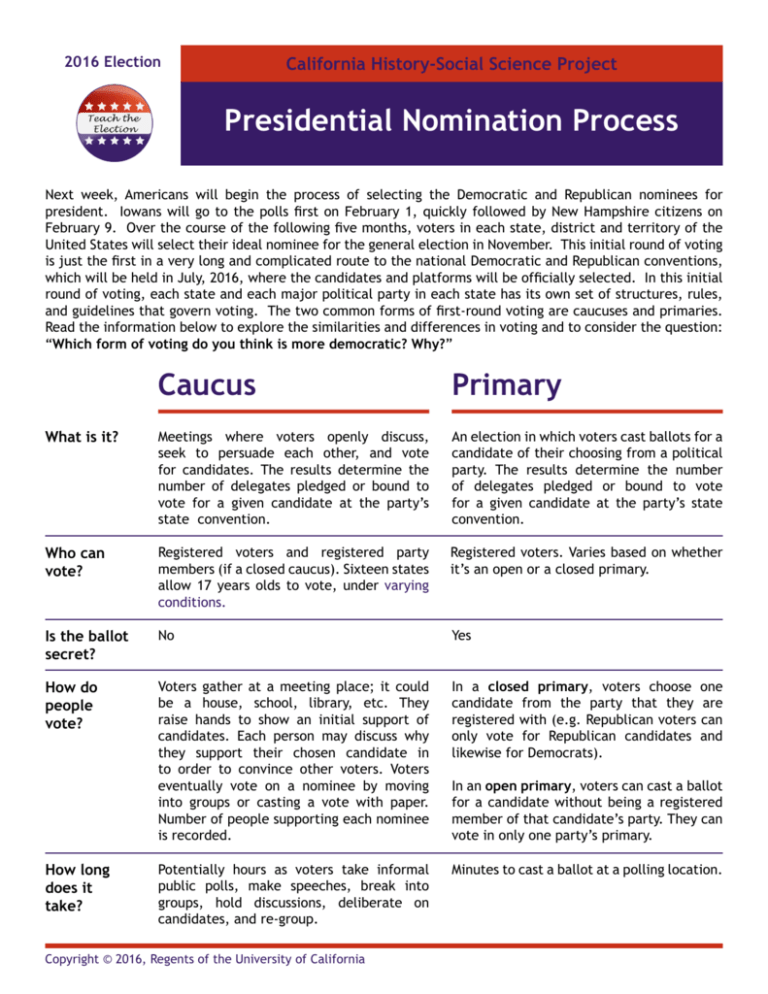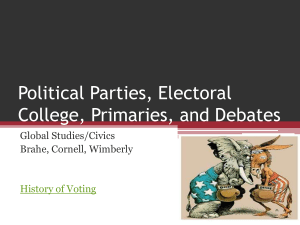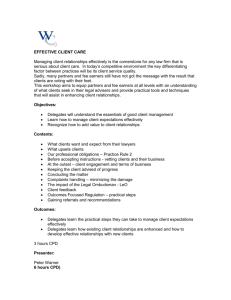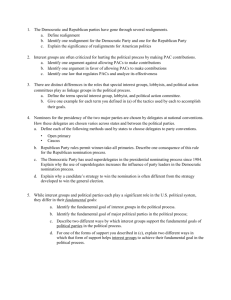
2016 Election
California History-Social Science Project
Presidential Nomination Process
Next week, Americans will begin the process of selecting the Democratic and Republican nominees for
president. Iowans will go to the polls first on February 1, quickly followed by New Hampshire citizens on
February 9. Over the course of the following five months, voters in each state, district and territory of the
United States will select their ideal nominee for the general election in November. This initial round of voting
is just the first in a very long and complicated route to the national Democratic and Republican conventions,
which will be held in July, 2016, where the candidates and platforms will be officially selected. In this initial
round of voting, each state and each major political party in each state has its own set of structures, rules,
and guidelines that govern voting. The two common forms of first-round voting are caucuses and primaries.
Read the information below to explore the similarities and differences in voting and to consider the question:
“Which form of voting do you think is more democratic? Why?”
Caucus
Primary
What is it?
Meetings where voters openly discuss,
seek to persuade each other, and vote
for candidates. The results determine the
number of delegates pledged or bound to
vote for a given candidate at the party’s
state convention.
An election in which voters cast ballots for a
candidate of their choosing from a political
party. The results determine the number
of delegates pledged or bound to vote
for a given candidate at the party’s state
convention.
Who can
vote?
Registered voters and registered party
members (if a closed caucus). Sixteen states
allow 17 years olds to vote, under varying
conditions.
Registered voters. Varies based on whether
it’s an open or a closed primary.
Is the ballot
secret?
No
Yes
How do
people
vote?
Voters gather at a meeting place; it could
be a house, school, library, etc. They
raise hands to show an initial support of
candidates. Each person may discuss why
they support their chosen candidate in
to order to convince other voters. Voters
eventually vote on a nominee by moving
into groups or casting a vote with paper.
Number of people supporting each nominee
is recorded.
In a closed primary, voters choose one
candidate from the party that they are
registered with (e.g. Republican voters can
only vote for Republican candidates and
likewise for Democrats).
Potentially hours as voters take informal
public polls, make speeches, break into
groups, hold discussions, deliberate on
candidates, and re-group.
Minutes to cast a ballot at a polling location.
How long
does it
take?
Copyright © 2016, Regents of the University of California
In an open primary, voters can cast a ballot
for a candidate without being a registered
member of that candidate’s party. They can
vote in only one party’s primary.
National Conventions
Once votes have been cast at the state level, delegates, or representatives, from each state’s party will travel
to the party’s national convention. Republicans will meet in Cleveland, and Democrats will convene their
convention in Philadelphia a week later. The purpose of the party convention is for delegates to come together
and officially nominate the presidential candidate for their party and to decide on their party’s platform, their
goals and policies.
What
are
delegates?
How are
delegates
selected?
Democratic National Convention
Republican National Convention
‘Pledged’ delegates are bound to vote for a
particular candidate at the state and national
party conventions.
‘Bound’ delegates are bound to vote for
a particular candidate at the state and
national party conventions.
‘Unpledged’ delegates can choose who they
vote for.
‘Unbound’ delegates can choose who they
vote for.
There is no legal enforcement mechanism
to guarantee how a delegate votes at the
convention.
There is no legal enforcement mechanism
to guarantee how a delegate votes at the
convention.
Delegates from California = 546
(11.98% of all national convention delegates)
Delegates from California = 172
(6.96% of all national convention delegates)
Total delegates at national convention =
4,764
Total delegates at national convention =
2,472
The candidate who wins the vote of at least
2,383 delegates at the national convention
will be the Democratic Presidential Candidate
in the general election on November 8, 2016.
The candidate who wins the vote of at least
1,237 delegates at the national convention
will be the Republican Presidential Candidate
in the general election on November 8, 2016.
The Democratic National Committee instructs
states to award delegates to candidates in
proportion to the percentage of votes the
candidate received (threshold of 15% of votes
to be eligible for a delegate).
The Republican National Committee allows
states to choose proportional representation
(to award delegates to candidates in proportion
to the percentage of votes the candidate
received (thresholds vary by state)), or all
bound delegates are allocated to the winner
of the most votes (aka winner take all), or a
mix of these.
For example, if Clinton wins 49% of the
California Democratic Primary vote, Sanders
wins 37%, and O’Malley wins 14%, then at the
Democratic National Convention, two-thirds
of the pledged delegates from California will
be expected to vote for Clinton; one-third for
Sanders; and O’Malley will have no pledged
delegates voting for him.
2
Teach the 2016 Election
Copyright © 2016, Regents of the University of California
Links
2016 Primary Schedule
http://www.uspresidentialelectionnews.
com/2016-presidential-primary-schedulecalendar/
Iowa Democratic Party Caucuses
http://iowademocrats.org/caucus/
Republican Delegate Allocation 2016
h t t p s : / / b a l l o t p e d i a . o r g / Re p u b l i c a n _
National_Convention,_2016
Democratic Delegate Allocation 2016
https://ballotpedia.org/Democratic_
National_Convention,_2016
Republican Party of Iowa Caucuses
https://www.iowagop.org/caucus/
Teach the Election
About Teach the Election
Contact
The California History-Social Science Project
Teach the Election puts the 2016 Election in its historical
context with classroom-ready explanations of the electoral
process, relevant issues, and suggestions to incorporate
the election cycle into the regular curriculum. Teach the
Election also helps students engage with informational text
and primary sources to help them make the evidence-based
arguments required by California’s Standards.
University of California, Davis
162 Kerr Hall
One Shields Avenue
Davis, CA 95616
Teach the Election is a publication of the California HistorySocial Science Project, a statewide network, headquartered
at the University of California, Davis, and dedicated to
improving student literacy and learning. Copyright © 2016,
Regents of the University of California. All rights reserved.
530.752.0572
For more information or to subscribe, visit http://chssp.
ucdavis.edu/programs/election, or contact the CHSSP
Statewide Office.
http://chssp.ucdavis.edu
chssp@ucdavis.edu
fax: 530.752.8202
www.facebook.com/
californiahistorysocialscienceproject
@CHSSP_SO
#tchelect
www.pinterest.com/CHSSP_SO
Copyright © 2016, Regents of the University of California
Presidential Nomination Process
3










